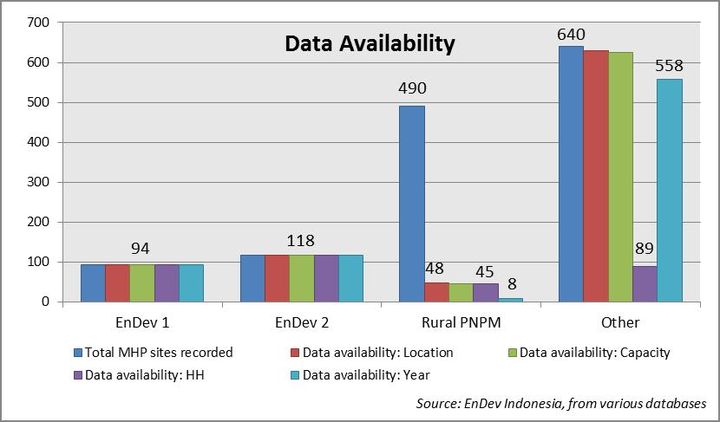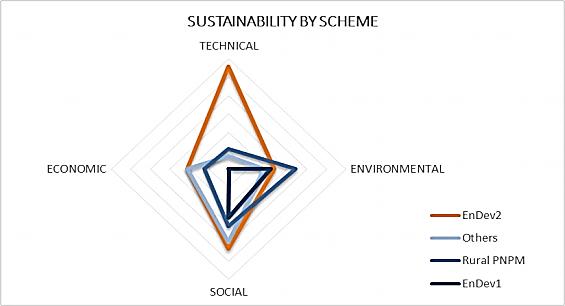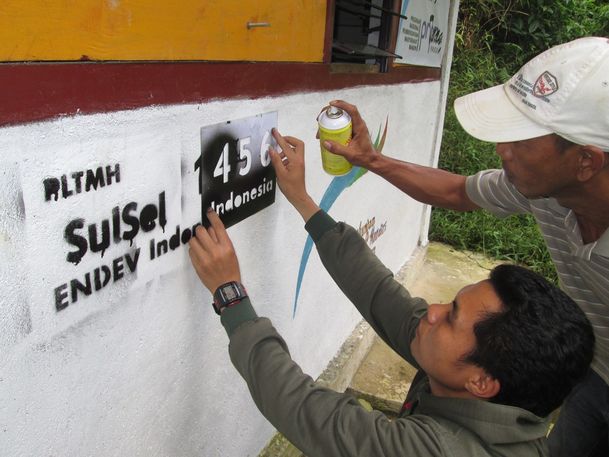Overview
Energising Development (EnDev) Indonesia launched its second phase in 2009, known as EnDev2.
EnDev2’s objective was to:
- support sustainable access to modern energy services for rural communities in Indonesia and
- to consolidate the gained Micro Hydro Power (MHP) expertise for the counterpart and sector stakeholders.
Monitoring the provision of modern energy access is relatively straightforward however, sustainable access requires a long-term monitoring intervention ideally with comparison to a baseline.
About the Study
-> Download “EnDev2 Impact on Sustainability – A Comparative Study (EnDev Indonesia 2013).pdf”
In April 2013, EnDev2 launched a study, as a means to commence with assessing the sustainability impacts of its support to Green PNPM (National Programme for Community Empowerment), by comparing its “success/failure” with other non-EnDev2 Micro Hydro Power (MHP) support initiatives against a set of sustainability factors. This “comparative study” was concluded in June 2013 and its findings are reported herein.
Objective and Research Question
The overall objective was to assess the hypothesis that “the EnDev2 concept improves the sustainability of off – grid MHP systems compared to other off – grid MHP support schemes in defined project areas of Indonesia”.
This study was conducted as an investigation and comparison into the social, economic, environmental and technical sustainability of the MHP systems falling into and outside the EnDev 2 support scheme for selected areas in Sulawesi Selatan and Sulawesi arat. To test the hypothesis , a research question was formulated: “ Does the EnDev 2 concept improve the sustainability of the MHPs compared to other off – grid MHP schemes in Sulawesi? ”
This central question lead to four further deriva tive sub – questions on various aspects of sustainability:
- Technical sustainability: to what extent guarantee the design and the hardware of the installed MHP systems medium to long (ML) term operations while offering a high – quality output of electricity produced?
- Social sustainability: to what extent have the local communities (benefiting from the MHP systems) been involved and made active participants in order to guarantee the self – sustainability of the operations in the ML term?
- Economic sustainability: to what extent have economic considerations been addressed and actions put in place over the life cycle of the systems in order to maximize the economic sustainability of the MHP systems in the ML term?
- Environmental sustainability: to what extent have environmental boundaries been taken into consideration and their importance associated to the ML term operations of the MHP systems acknowledged?
Preceding the field-based survey of the comparative study, a situational analysis was conducted, in an attempt to collect and review available data on MHPs at a national level. Data was sought from different public and private agencies involved in funding and supporting MHP development in Indonesia. Apart from EnDev2 (and its predecessor EnDev1) data records were wholly inadequate and in the best case only provided some basic data (such as installation location, installed capacity and/or year of installation). Unfortunately in almost 40% of over 1,300 MHP sites recorded in Indonesia, not even this rudimentary data was centrally available. Particularly government-funded programmes (which account for over 75% of funding for MHPs installed) are at risk, since lack of data does not allow for planning, monitoring and adjusting their rural electrification programmes.
 Sustainability is a process of continuous improvement from lessons learnt, rather than a fixed position. Improvement requires monitoring, which in turn is only possible if sufficient data are meticulously collected, inventoried, regularly analysed and available. If data availability and comprehensiveness are regarded as necessary towards sustainability, EnDev2 sites have far great prospects than sites supported through any other programme.
Sustainability is a process of continuous improvement from lessons learnt, rather than a fixed position. Improvement requires monitoring, which in turn is only possible if sufficient data are meticulously collected, inventoried, regularly analysed and available. If data availability and comprehensiveness are regarded as necessary towards sustainability, EnDev2 sites have far great prospects than sites supported through any other programme.
Results
The field-based comparative study undertook in-depth surveys of 32 sites in Sulawesi, Indonesia. The sites included EnDev2 and various non-EnDev2 MHP installations. The overriding finding was that EnDev2 MHP sites perform far better in terms of technical sustainability, while being amongst the top performers for economic and social sustainability. Environmental sustainability appears to lag behind, but this is due to natural events beyond control.
 Of particularly delight was the revelation that overall MHP sustainability in Indonesia appears to improve. While both EnDev1 and EnDev2 are reluctant to claim full credit, several sustained sector interventions by these projects undoubtedly contributed towards this steady improvement.
Of particularly delight was the revelation that overall MHP sustainability in Indonesia appears to improve. While both EnDev1 and EnDev2 are reluctant to claim full credit, several sustained sector interventions by these projects undoubtedly contributed towards this steady improvement.
Chapter 2 of this report explains the rationale for this comparative study, while Chapter 3 provides contextual background information and describes the different MHP support schemes assessed. The chapter also present the results of the situational analysis conducted prior to the comparative study and field surveys. Chapter 4 is dedicated to the methodology of the comparative study to demonstrate that a scientifically objective approach was pursued, within the logistical and resource limitations at hand. Chapter 5 then presents the findings of the comparative study. The comparative study was conducted by a master student for the elaboration of his master thesis, and this chapter extracts the most pertinent results. This report concludes with Annex A, which describes the non-operational MHP sites discovered during the field surveys in more detail.
References
- ↑ 1.0 1.1 EnDev Indonesia
- ↑ Andrea Ranzanici (GIZ, 2013)
Further Information
- Green PNPM (Homepage)
- EnDev (Energising Development) (Homepage)
- Green PNPM (National Programme for Community Empowerment
- EnDev2 Indonesia Impact on Sustainability – A Comparative Study (final report, pdf)
